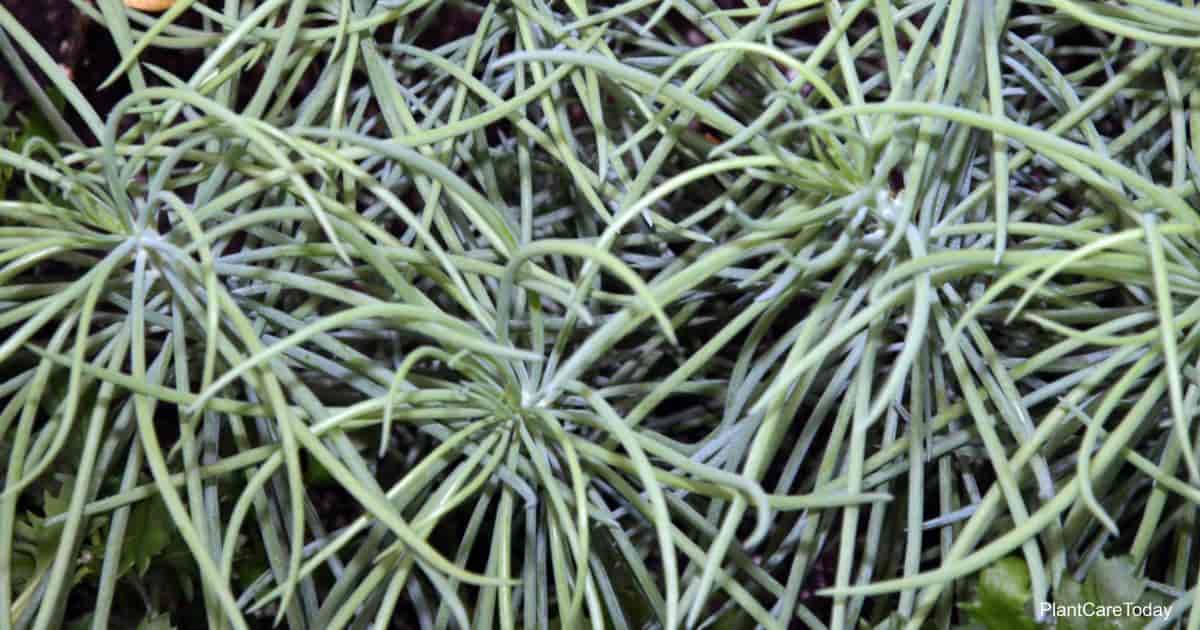Senecio Vitalis [sen-NEESH-shee-oh, vi-TAL-is] is also known as Narrowleaf Chalksticks.
This popular, ornamental spreading evergreen succulent plant hails from the Eastern Cape of South Africa and is a member of the Asteraceae family.

Senecio vitalis has several synonyms including:
- Senecio cylindricus
- Senecio talinoides subs. cylindricus
- Kleinia cylindrica
You may hear it by the following common names including:
- Blue Chalk Fingers
- Blue Chalk Stick
- Narrow-leaf Chalksticks
Senecio Vitalis Care
Vitalis is closely related to other blue chalk fingers Senecio varieties like the popular Senecio mandraliscae and the other very similar in appearance Senecio serpens.
Size & Growth
The stems of the plant emerge as upright, but as they grow in length, they tend to droop and ramble along the ground.
At any point where the stem comes in contact with the earth, roots will form.
Narrow-leaf Chalksticks’ rapid, rambling growth habit allows this succulent to form dense mats as an effective groundcover.
The plant may grow to be 2′ feet high, and each plant can spread to be 3′ – 5′ feet wide.
The plants’ leaves are a blue-green, slim, and slightly upward curve.
These green leaves are typically 3″ – 5″ inches long and grow in a circular formation around attractive trailing stems.
At the tip of the stem, the leaves grow in a tuft.
Flowering & Fragrance
During bloom time in late spring and early summer, clusters of small white flowers appear on corymbs rising just above the plants’ foliage.
As with most succulent flowers, pollinators appreciate these tiny blooms.
Light & Temperature
Narrow-leaf Chalksticks is winter hardy in hardiness zones 10 and 11 (USDA Zones) and can tolerate temperatures as low as 30° degrees Fahrenheit (-1° C).
Senecio cylindricus growth period spans the winter months, and the plant is fairly inactive or dormant throughout the summer.
This adaptable, cheery plant grows equally well in full sun or light shade.
Watering & Feeding
Senecio cylindricus is very drought tolerant. However, follow typical succulent water needs by watering thoroughly and then allowing the soil to dry completely before watering again.
Senecio can do quite well with no fertilizer, but it will appreciate a top dressing of natural compost every couple of years.
Soil & Transplanting
Like most succulent shrubs, this drought-tolerant plant likes well-draining soil types with high sand content.
It tolerates all pH levels from acidic to alkaline.
If planting in a container, use standard cacti or succulent potting mix.
Amend with potting soil or worm castings to add a little more nourishment.
Grooming & Maintenance
Stems can become excessively long, and when this happens, older growth may be bare with fresh new growth only at the ends.
Regular pruning helps prevent this unattractive state of affairs.
Annual hard pruning just before the start of the growing season produces all fresh growth.
It’s a good idea to prune this roaming succulent to control its size and spread.
How To Propagate Narrow Leaf Chalksticks
It’s easy to propagate Narrow Chalksticks from cuttings.
- Using a sharp knife or scissors, take a cutting near the plant’s base.
- Set the cutting in a warm, sheltered area with good air circulation for a couple of days to allow the cut end to callous over.
- Place the cutting in a container or location with well-draining soil kept slightly moist.
- Roots should form within a couple of weeks.
Narrow-Leaf Chalksticks Pests or Diseases
As with all succulents, too much water and too little drainage will cause problems with fungal infections and pests such as succulent mealybug pests and aphids.
Be careful not to overcrowd or over water your plants.
Provide good quality, sharply draining soil, and avoid overhead watering, and you should experience few pests or disease problems.
Are Chalksticks Toxic or Poisonous?
The sap of Senecios is mildly irritating; therefore, take care when transplanting.
Wear protective gloves and wash up thoroughly.
It is also not a good choice for yards where pets and small children may be present as it is toxic.
Is The Senecio Vitalis Plant Invasive?
In conducive environments, Narrowleaf Chalksticks is mildly invasive.
Keep an eye on it and keep it trimmed back to prevent having it escape and ramble away.
Suggested Senecio Cylindricus Chalksticks Uses
This deer-resistant plant naturalizes easily in a wide variety of settings.
It is a good choice for Mediterranean gardens, succulent gardens or rock gardens when paired with Kalanchoe, Agave or large Aloe.
It does well as a bedding plant or border plant.
It is an interesting choice in containers and even hanging baskets, but it does not do well when grown indoors as a house plant.